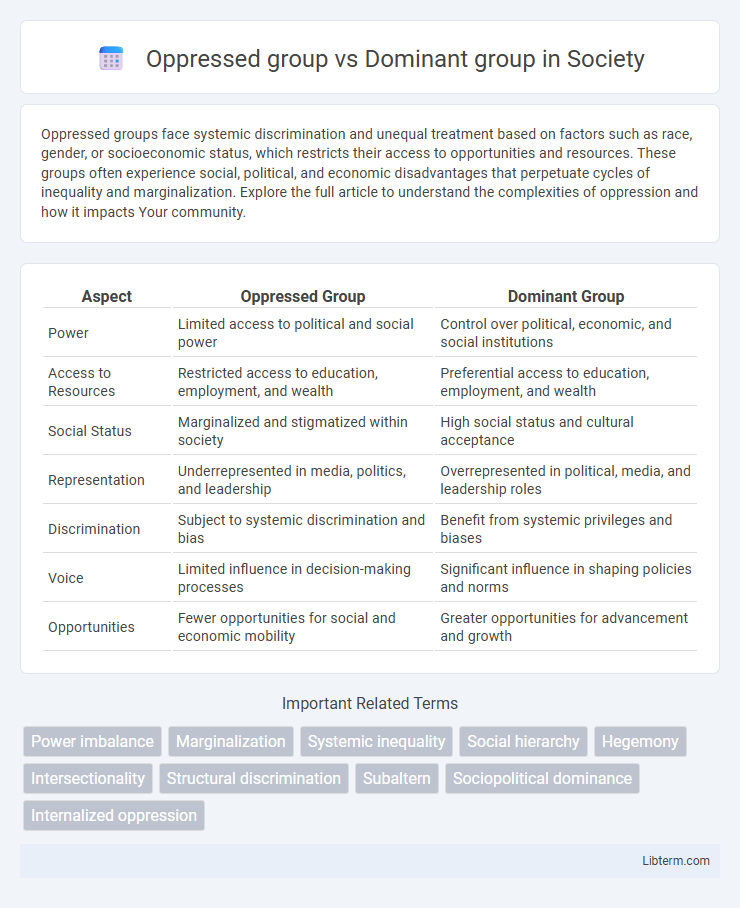Oppressed groups face systemic discrimination and unequal treatment based on factors such as race, gender, or socioeconomic status, which restricts their access to opportunities and resources. These groups often experience social, political, and economic disadvantages that perpetuate cycles of inequality and marginalization. Explore the full article to understand the complexities of oppression and how it impacts Your community.
Table of Comparison
| Aspect | Oppressed Group | Dominant Group |
|---|---|---|
| Power | Limited access to political and social power | Control over political, economic, and social institutions |
| Access to Resources | Restricted access to education, employment, and wealth | Preferential access to education, employment, and wealth |
| Social Status | Marginalized and stigmatized within society | High social status and cultural acceptance |
| Representation | Underrepresented in media, politics, and leadership | Overrepresented in political, media, and leadership roles |
| Discrimination | Subject to systemic discrimination and bias | Benefit from systemic privileges and biases |
| Voice | Limited influence in decision-making processes | Significant influence in shaping policies and norms |
| Opportunities | Fewer opportunities for social and economic mobility | Greater opportunities for advancement and growth |
Defining Oppressed and Dominant Groups
Oppressed groups are social collectives systematically subjected to marginalization, discrimination, and limited access to resources and opportunities due to factors like race, gender, class, or ethnicity. Dominant groups hold institutional power, control social norms, and influence economic and political systems, perpetuating inequality through privilege and systemic advantages. Understanding the dynamics between oppressed and dominant groups is essential for analyzing social hierarchies and addressing structural inequities.
Historical Contexts of Oppression
Oppressed groups have historically faced systemic inequalities enforced by dominant groups through laws, social norms, and institutional practices that maintain power imbalances. Examples include racial segregation under Jim Crow laws in the United States and apartheid in South Africa, which legally codified discrimination and limited access to resources for marginalized communities. These historical contexts reveal patterns of exclusion, economic disenfranchisement, and cultural suppression imposed by dominant groups to sustain control.
Power Dynamics Between Groups
Oppressed groups experience systemic barriers and limited access to resources while dominant groups maintain control over social, economic, and political institutions, reinforcing unequal power structures. Power dynamics between these groups are characterized by the dominance of the privileged group in decision-making processes, cultural representation, and policy formation, perpetuating cycles of marginalization. These imbalances manifest through institutional discrimination, social exclusion, and disparities in wealth, education, and influence, sustaining the dominance of one group over another.
Systemic Inequality and Its Effects
Systemic inequality manifests through institutional policies and social structures that privilege dominant groups while marginalizing oppressed groups, resulting in disparities in wealth, education, healthcare, and political representation. Oppressed groups often face cumulative disadvantages that limit access to resources and opportunities, perpetuating cycles of poverty and social exclusion. These entrenched disparities undermine social cohesion and hinder equitable development across communities.
Cultural Narratives and Representation
Oppressed groups often face underrepresentation and misrepresentation in dominant cultural narratives, which perpetuates stereotypes and marginalizes their experiences. Dominant groups typically control media and storytelling platforms, shaping cultural narratives that reinforce their own values and maintain systemic power structures. Accurate and diverse representation of oppressed groups challenges these dominant narratives, fostering greater social equity and cultural understanding.
Economic Disparities and Access
Oppressed groups often face significant economic disparities, including lower wages, higher unemployment rates, and limited access to quality education and healthcare compared to dominant groups. These disparities hinder social mobility and perpetuate cycles of poverty within marginalized communities. Access to financial resources, credit, and job opportunities remains disproportionately skewed in favor of dominant groups, reinforcing systemic inequality.
Resistance and Social Movements
Oppressed groups mobilize through resistance and social movements to challenge systemic inequalities imposed by dominant groups, utilizing tactics such as protests, advocacy, and grassroots organizing to demand social, political, and economic change. Dominant groups often attempt to maintain power through institutional control, cultural hegemony, and legal frameworks, which resistance movements strategically confront to disrupt entrenched privilege. The dynamic between oppressed and dominant groups shapes the evolution of social justice efforts, with intersectional activism highlighting the interconnected nature of oppression and resistance.
Intersectionality Within Groups
Intersectionality within oppressed and dominant groups reveals how overlapping identities such as race, gender, class, and sexuality create unique experiences of privilege and marginalization. Oppressed group members may face compounded discrimination based on intersecting factors, while dominant group individuals hold varying degrees of power depending on their specific identity intersections. Understanding these layered dynamics is essential for addressing systemic inequality and fostering inclusivity within social structures.
The Role of Allies and Advocacy
Allies in dominant groups play a crucial role in amplifying the voices of oppressed groups by advocating for equitable policies and challenging systemic injustices. Effective advocacy involves leveraging social, economic, and political influence to dismantle power imbalances and promote inclusivity. Solidarity from allies fosters a more just society by supporting marginalized communities' rights and amplifying their struggles.
Paths Toward Equity and Justice
Oppressed groups face systemic barriers that limit access to resources, opportunities, and political power, while dominant groups maintain societal control through institutional privileges. Paths toward equity and justice involve dismantling structural inequalities, promoting inclusive policies, and amplifying marginalized voices to ensure fair representation and resource distribution. Empowering oppressed communities through education, legal reforms, and economic opportunities creates sustainable social change and fosters true equity.
Oppressed group Infographic

 libterm.com
libterm.com